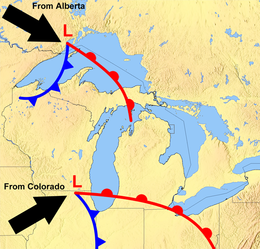
Back Great Lakes Storm of 1913 German Tempête de 1913 sur les Grands Lacs French Grote Merenstorm van 1913 Dutch Stormen på Stora sjöarna 1913 Swedish
 A surface analysis map showing the convergence of two systems to form a typical November gale | |
| Type | Extratropical cyclone Winter storm Blizzard |
|---|---|
| Formed | November 6, 1913 |
| Dissipated | November 11, 1913 |
| Highest gust | 90 mph (145 km/h) |
| Lowest pressure | 968.5[1][2] mb (28.60 inHg) |
| Areas affected | The Great Lakes Basin in the Midwestern United States and the Canadian province of Ontario |
The Great Lakes Storm of 1913 (historically referred to as the "Big Blow",[3][a] the "Freshwater Fury", and the "White Hurricane") was a blizzard with hurricane-force winds that devastated the Great Lakes Basin in the Midwestern United States and Southwestern Ontario, Canada, from November 7 to 10, 1913. The storm was most powerful on November 9, battering and overturning ships on four of the five Great Lakes, particularly Lake Huron.
The storm was the deadliest and most destructive natural disaster to hit the lakes in recorded history. More than 250 people were killed. Shipping was hard hit; 19 ships were destroyed, and 19 others were stranded. About $1 million of cargo weighing about 68,300 tons—including coal, iron ore, and grain—was lost. The storm impacted many cities, including Duluth, Minnesota; Chicago, Illinois; and Cleveland, Ohio, which received 22 in (56 cm) of snow combined with winds up to 79 mph (127 km/h) and was paralyzed for days. The extratropical cyclone originated when two major storm fronts that were fueled by the lakes' relatively warm waters—a seasonal process called a "November gale"—converged. It produced wind gusts of 90 mph (140 km/h), waves estimated at over 35 feet (11 m) high, and whiteout snowsqualls. Winds exceeding hurricane force occurred over four of the Great Lakes for extended periods creating very large waves. The large size of the Great Lakes provides wind fetches (the length of water over which a given wind has blown without obstruction) of hundreds of miles, allowing huge waves to form. Rogue waves are known to occur on the Great Lakes, including waves reinforced by reflections from the vertical shores of some of the Great Lakes.
The U.S. Weather Bureau failed to predict the intensity of the storm, and the process of preparing and communicating predictions was slow. These factors contributed to the storm's destructiveness.[4] The contemporaneous weather forecasters did not have enough data, communications, analysis capability, and understanding of atmospheric dynamics to predict the storm. They could not predict wind directions, which is key to the ability of ships to avoid or cope with the effects of storms.
- ^ Cite error: The named reference
2013nwsreviewwas invoked but never defined (see the help page). - ^ Cite error: The named reference
usgovdatawas invoked but never defined (see the help page). - ^ Brown 2002, p. 201.
- ^ Scott, Chris (November 10, 2014). "The White Hurricane: The worst storm in Great Lakes history". The Weather Network. Retrieved March 23, 2017.
The Great Storm of 1913, known as the 'White Hurricane'
Cite error: There are <ref group=lower-alpha> tags or {{efn}} templates on this page, but the references will not show without a {{reflist|group=lower-alpha}} template or {{notelist}} template (see the help page).
© MMXXIII Rich X Search. We shall prevail. All rights reserved. Rich X Search